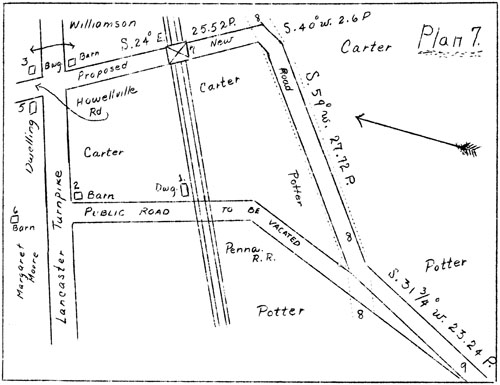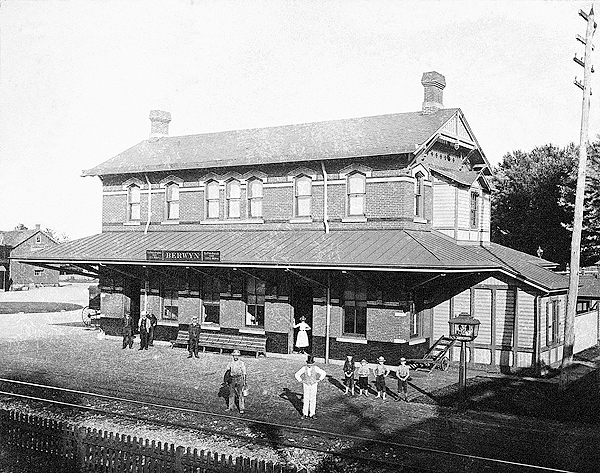| Tredyffrin Easttown Historical Society Home : Tredyffrin History : Railroads : Main Line Use the links at left of the article to return. |
Berwyn |
|
It was only a short time after Reeseville officially became Berwyn in 1877 that an effort was begun to replace the old flag stop on the railroad there, established eight years earlier, with a new passenger and freight depot. Berwyn, at that time, had grown to a village of about 200 inhabitants, with forty or so dwellings. In the village there were also a Presbyterian church, a general store, a feed, lumber and coal yard, a tin shop, a carpenter shop, a carpet weaving shop, a harness shop, and blacksmith and wheelwright establishments. The area’s farmers also supplied foodstuffs and agricultural products -- milk, meats, poultry, eggs, butter, cheese, and, in season, fresh fruits and vegetables -- for the Philadelphia markets, shipped on a daily milk train or in special market cars twice a week. “The Berwyn market car was often insufficient to hold all the dressed meat, butter tubs, and egg boxes,” Franklin L. Burns has reported, and in April 1879 it was reported in the West Chester Daily Local News [Chester County Historical Society] that 900 quarts of milk had been shipped from the Berwyn railroad station on the previous Sunday morning, with traffic “on the increase from that station”. In the same issue of the Local it was also reported, “That flourishing village, Berwyn, on the Pennsylvania Railroad, is to have a new passenger office and freight depot, which will be thirty feet square and two and a half stories high. The engineers are expected to be at that place to-day to lay out the grounds, and the work will be commenced at once. The plans show that the building will be neat and pretty.” The report, however, seems to have been somewhat premature, for fifteen months later, in early July of 1880, it was reported, “The citizens of Berwyn held a meeting on Thursday evening last and resolved to again petition the Pennsylvania Railroad for a new and more commodious depot at that place. A committee was appointed to draw up and circulate a petition requesting the Company to build one. It appears from the statements that the receipts of that place during the month of June for passengers alone amounted to $643.15. They think the business of the place warrants a better depot. We hope their efforts will be crowned with success.” The committee was headed by Isaac A. Cleaver, with the petition it drew up available for signatures at his store. By the end of the month the petition, addressed to Frank Thompson, General Manager of the Pennsylvania Railroad, already had a number of “signatures of those who believe that to Berwyn rightfully belongs a new passenger and freight station”. This effort was more successful. On November 17, 1880, it was reported: “The engineers of the Pennsylvania Railroad were at Berwyn a day or two ago and surveyed the ground for a new depot and warehouse, which will probably be constructed together. A new depot at that place,” it was added, “is much needed. The business of that place is quite large and constantly increasing and the patrons of the road desire better accommodations than they now have.” In February the following year it was announced that a "new brick depot, two stories, with ample accommodations for passengers and freight and residence for a family, will be one of the early spring improvements, to be commenced before June 15th next.” It was also predicted that the new station at Berwyn would make the depot at West Chester “a pigmy in comparison”! The new structure was to have a front of 50 feet and a depth of 22 feet. The low bidder for the project was a J. B. Gibson, of Berwyn. When he “for some cause threw up the same”, the contract was awarded to the next lowest bidder. Work was begun in early April, it being reported in the Local on April 15th, that the “digging of the foundation was commenced on Monday”. Two weeks later, on April 28th, however, it was noted, “The Pennsylvania Railroad Company have changed the site for the location of their new depot at Berwyn. The foundation of the first one had been dug, but at the solicitations of the citizens of that place, changed it, and they are now filling up the trenches of the first foundation with the earth taken from the last.” In its new location, the building was to be 54 feet long and 20 feet wide. The first story was to be 15 feet high, and the second story 10 feet. Constructed of brick, ornamented with peerless glaze bricks and Ohio stone, it included a ticket office, a waiting room, and a bay window to be used as the telegraph office. 1874 - plans were made to re-align Leopard Road and use a new bridge. June 11, 1877 “REESEVILLE NOW CALLED BURWYN. .- A correspondent writing to the Lancaster New Era from Reeseville, this county, speaks of that place about to take a new name, that of ‘Burwyn.’ He says: This is a rural place of about twenty houses, yet quite a business station on the direct line of the Pennsylvania railroad. The latter company propose to change the name of the station to Burwyn, after a high point in Wales which over-looks the valley of the river Dee. The railroad officials are partial to Welsh names, and Burwyn is not only euphonius, but descriptive of the locality. Next will follow the application of the name to the post-office, an acceptable change, indeed, for at present our letters are apt to be left at Reedsville, Reevesville, Rouseville and other offices similar in sound and chirography.” February 15, 1879 “Jumped the Track. – The P.R.R engine, Modoc, jumped the track this morning at Berwyn while passing off the middle to the south track. No damage was done except to impede the travel for two or three hours.” May 7, 1881 “New Depot at Berwyn. – The masons have commenced the stone work of the new depot of the Pennsylvania Railroad Company at Berwyn. Peter Burns has the contract for the stone work, and expects to have his part finished and ready for the bricklayers in about a week. Patterson & Smith, of Philadelphia, have the brick work. The building will be 22 by 54 feet, two stories high, the first 15 and the second 10 feet in height. It will be built of bricks and ornamented with peerless glazed bricks and Ohio stone. There will be a ticket office, a waiting room and a bay window; the latter will be used as a telegraph office.” June 1, 1881 “The Berwyn Depot. – Peter Burns, contractor, has completed the mason work of the new depot of the Pennsylvania Railroad at Berwyn. The base course is being laid, and the bricklayers will commence operations today. The building when completed will be a very neat and pretty one.” The brick work was under contract to Patterson & Smith, of Philadelphia. By the end of the third week in June the walls of the first story were completed, it being reported on June 23rd that “that the brickwork of the new station ... is well up to the second story and looks remarkably well. It is built of variegated colored bricks, red, black and yellow. At the same time, it was noted that the carpenters were at work “laying floors, &c”, though on June 7th it had been reported that the installation of the windows and doors had been held up by a fire at the supplier’s shop which had burned up the doors and sashes, compelling the contractor “to suspend operations for the present”. August 2, 1881 “New Railroad Stations. – The new station house which is being built by the Pennsylvania Railroad Company at the Eagle, has been raised and will be finished at an early day by the contractor, William H. Burns, of Berwyn. The new station house at Berwyn, for which Mr. Burns is also contractor, is progressing finely.” September 9, 1881 “The New Station at Berwyn. – The new station house at Berwyn is fast approaching completion. The building when finished will be quite attractive. The plasterers are engaged in putting the white coating on the walls and the carpenters and painters were following closely after them.
” In mid-December grading operations around the new station were started. “Thursday John Grant and sixteen of his men commenced grading around the PRR station at Berwyn,” it was announced in the Local for December 16th. “Mr. Grant says there is $1.50 per day and roast beef at dinner for all men who need work, if they will just put in their appearance at Berwyn.” The work was completed by early January the next year. (The care of the grounds, however, was a perennial problem: in September 1886, for example, it was reported, “The company is ...grading the grounds around the Berwyn station preparatory to putting in flower beds”, with a report two months later that, according to a “gentleman from Berwyn”, the Railroad was “fixing up the grounds around its station at that place in a handsome manner. The grounds are being sodded, flower beds made, and when completed the station will be a very different place.” A “substantial fence” was also built in front of the station in May of 1887.) May 8, 1882 Bridge Commenced. – The Pennsylvania Railroad Company commenced this morning the erection of a new bridge at Berwyn at Berwyn station, which will open an avenue from the Lancaster turnpike to the old Lancaster road, and also an avenue of the line between the Fritz estate and the property of Mr. John Keller. June 13, 1882 “Bridge at Berwyn – The mason work of the new bridge over the Pennsylvania Railroad, at Berwyn, has been completed, as well as the filling up of the approaches. The lumber to be used in its erection is also on the ground, and the fencing material is being hauled for the purpose of opening the avenue recently laid out leading from the Lancaster turnpike to the old Lancaster road and passing over the bridge.” In September 1886, work was begun on the construction of the warehouse, to the northeast of the station. The frame building stood for less than twenty years, however, before being destroyed by fire on July 22, 1904. According to newspaper accounts, it was believed that the fire was started by boys playing with matches, with a burning match having been thrown on the station platform, where it ignited the contents of a can of gasoline and started a fire that spread to the warehouse.
Photo by Julius Sachse from the Cassatt Avenue bridge in the summer of 1888. Notes and References
|

